Pork Cutting Diagram
Explore the Pork: From Butt to Leg
Pork butchery starts with understanding the big picture. The diagram above breaks down a side of pork into its primal cuts—the foundational sections a butcher works from. Each primal contains a range of retail cuts you’ll find at the store, each with its own characteristics, cooking methods, and flavor profiles.
Special Thanks To:
Primal Percentages of Carcass & Additional Data:


Edit Template
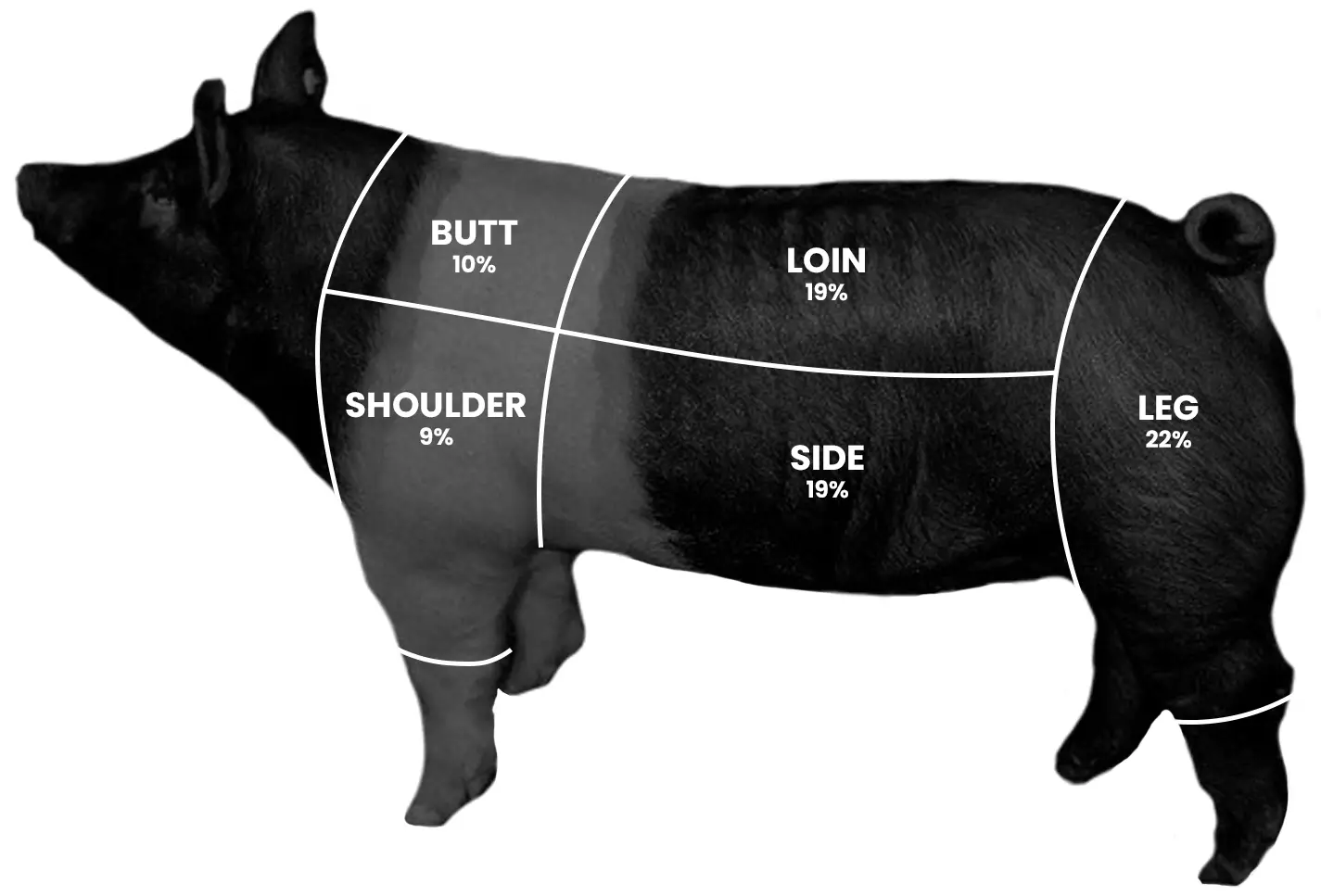
BUTT
Butt Primal
The pork butt, also known as the Boston Butt, comes from the upper part of the pig’s shoulder, above the picnic shoulder. Despite the name, it has nothing to do with the rear of the pig. This cut is known for its rich marbling and is ideal for slow cooking, smoking, or braising to break down the connective tissue, making it perfect for pulled pork and other shredded dishes.
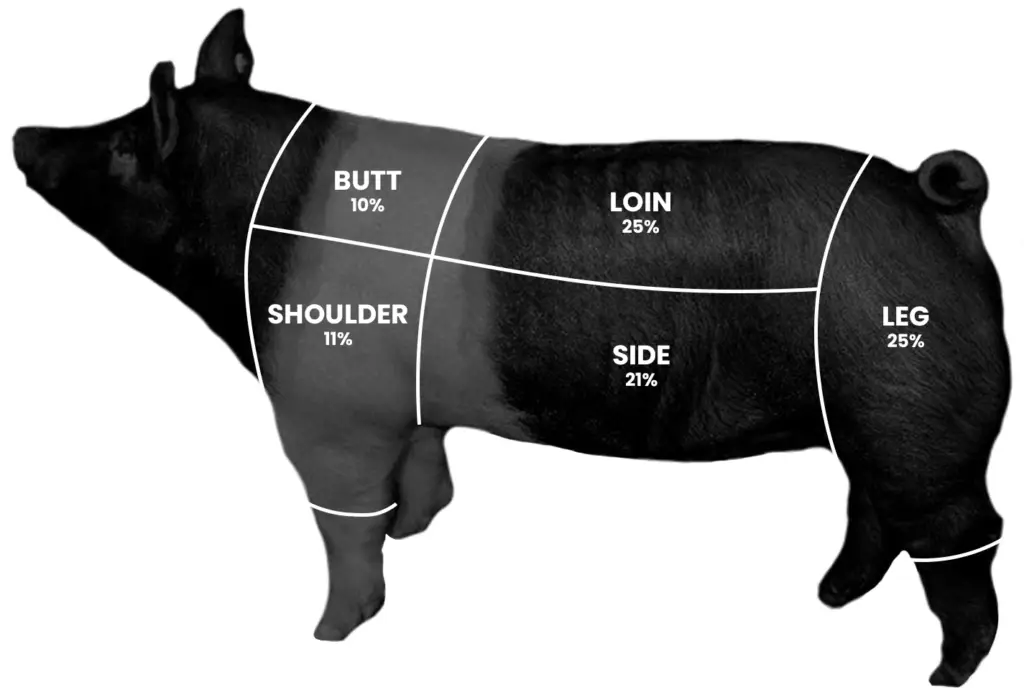
Some Cut Possibilities from the Butt
Please Note: You won’t receive all cuts listed below from a single animal. The final options depend on what you prioritize, and what your processor is able to provide. Depending on the number of cut options available from a single muscle, you can typically choose between two and four options for each primal area.
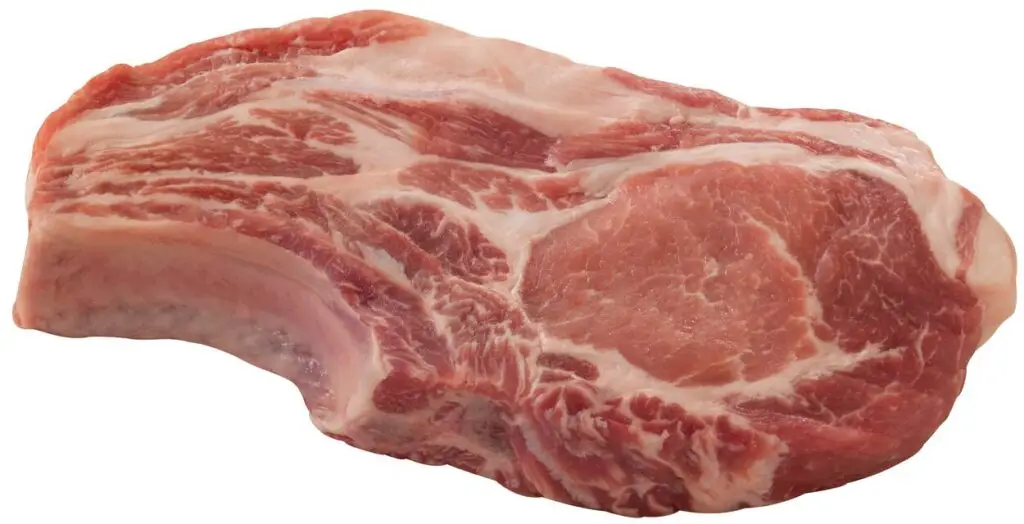
- Cooking Guide:
- Sauteing
- Braising
- Grilling
Flavorful steaks cut across the shoulder blade. Best when grilled or pan-seared, and often marbled for rich flavor.

- Cooking Guide:
- Braising
- Stewing
- BBQ
- Roast
A bone-in, versatile roast that’s ideal for shredding. Best cooked low and slow or smoked for deep flavor.
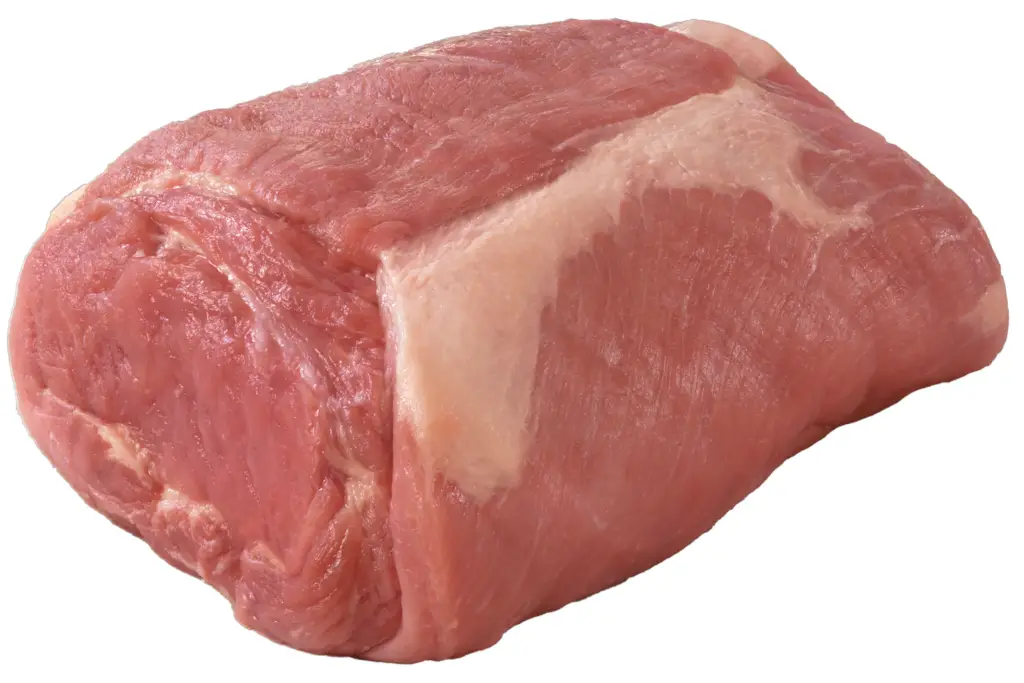
- Cooking Guide:
- Braising
- Stewing
- BBQ
- Roast
Great for long, slow cooking. This cut becomes incredibly tender when braised, roasted, or used in stews.
Special Thanks To:
Primal Percentages of Carcass & Additional Data:


Edit Template
LOIN
Loin Primal
The pork loin runs along the back of the pig from the shoulder to the leg. It provides some of the most popular and versatile cuts of pork — from tender roasts to quick-cooking chops. This section includes both bone-in and boneless options, offering a balance of tenderness and flavor. Cooking methods range from grilling and roasting to sautéing and barbecuing depending on the specific cut.

Some Cut Possibilities from the Loin
Please Note: You won’t receive all cuts listed below from a single animal. The final options depend on what you prioritize, and what your processor is able to provide. Depending on the number of cut options available from a single muscle, you can typically choose between two and four options for each primal area.

- Cooking Guide:
- BBQ
- Braise
- Roast
A bone-in loin roast often frenched for presentation. Great for roasting whole or slicing into thick chops.
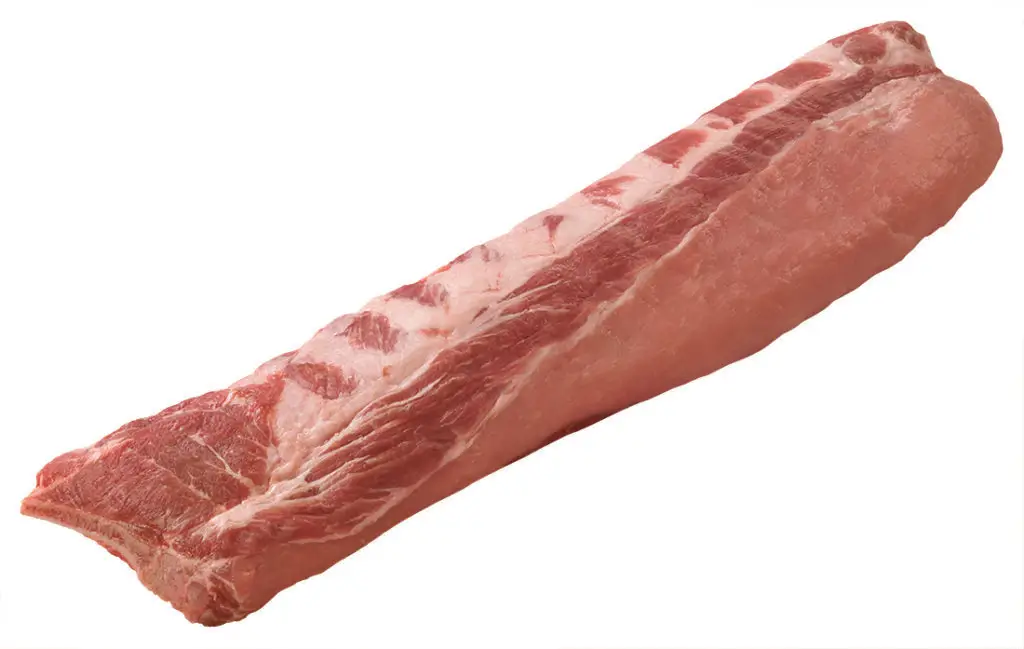
- Cooking Guide:
- BBQ
- Roast
- Stew
Curved ribs from the upper loin. Best cooked low and slow, then finished on the grill or under the broiler.
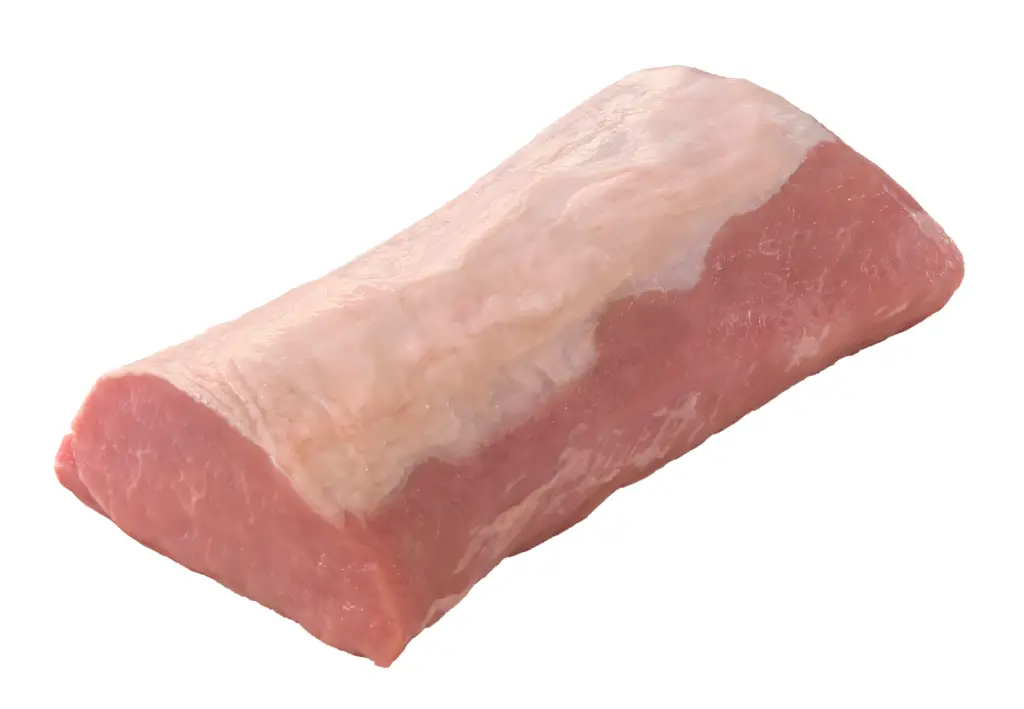
- Cooking Guide:
- Grill
- Roast
- Saute
A boneless, lean roast from the center loin. Best roasted whole or sliced into chops for grilling or baking.

- Cooking Guide:
- Grill
- Roast
- Saute
A lean, boneless chop from the top loin. Fast-cooking and great for grilling, roasting, or pan-searing.
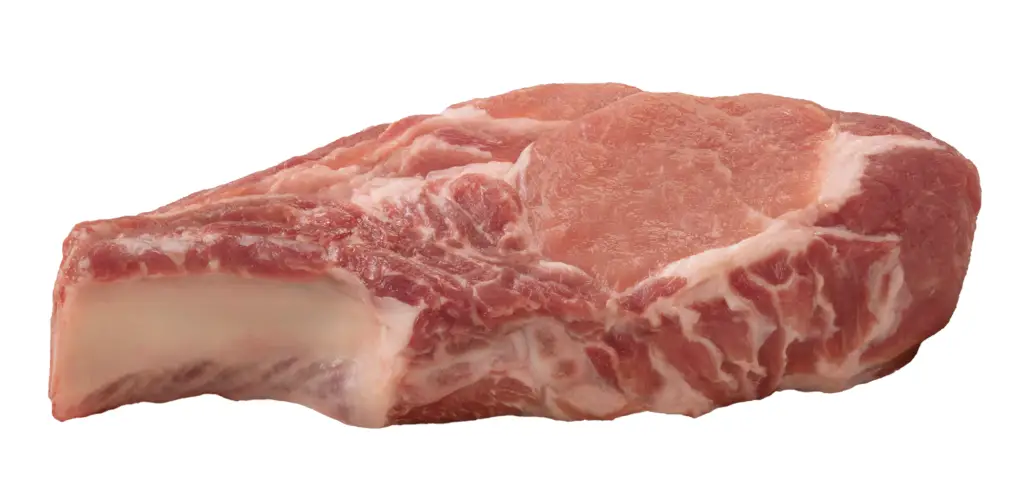
- Cooking Guide:
- Braise
- Roast
- Stew
Thick, meaty ribs from the front of the loin. Best when braised, stewed, or slow-roasted until fork tender.

- Cooking Guide:
- Braise
- Roast
- Stew
A lean roast from the rear loin. Best suited for moist heat cooking — roasting, stewing, or braising.

- Cooking Guide:
- Grill
- Roast
- Saute
Bone-in chop from the rib section of the loin. Tender, juicy, and excellent for grilling or pan-searing.
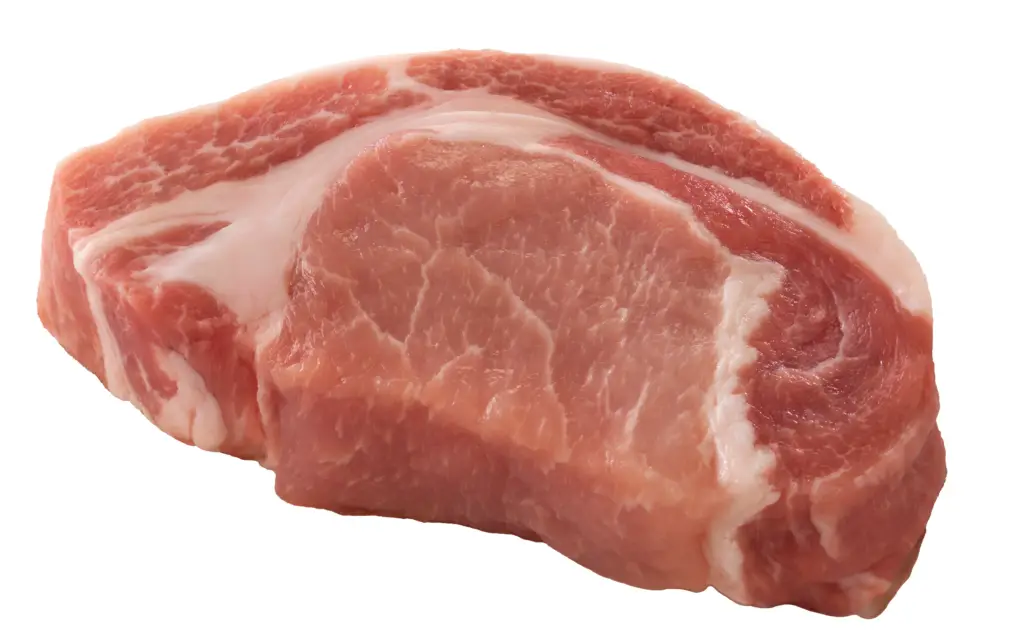
- Cooking Guide:
- Grill
- Roast
- Saute
Boneless version of the ribeye chop — great for quick cooking on the grill, stovetop, or in the oven.

- Cooking Guide:
- Braise
- Roast
- Stew
A flavorful roast from the sirloin end of the loin. Ideal for roasting or slow braising with aromatic herbs.
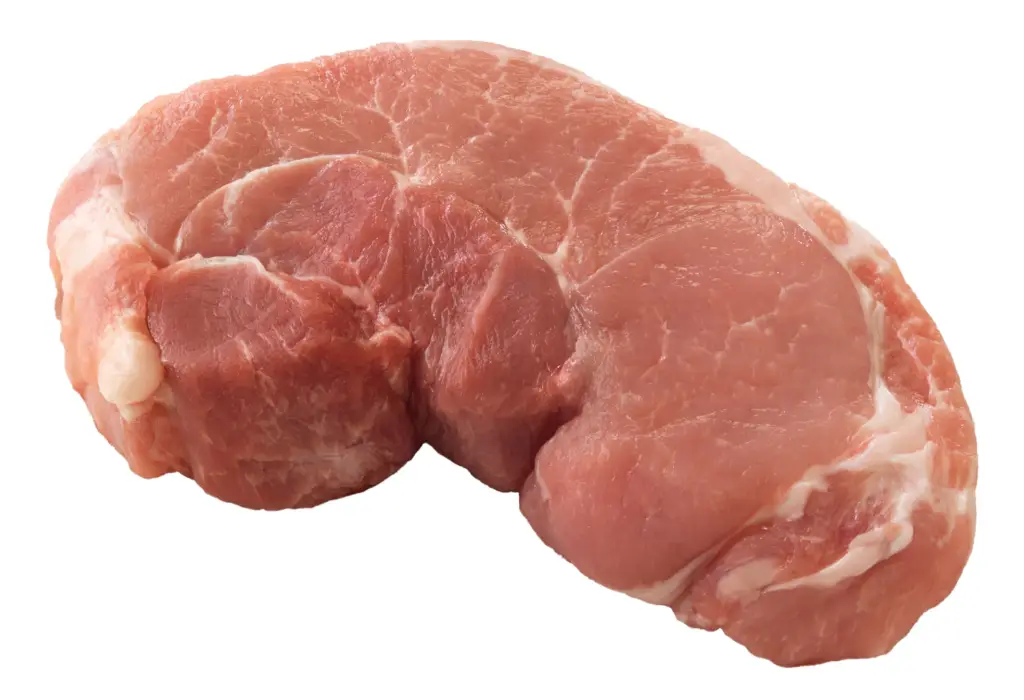
- Cooking Guide:
- Braise
- Roast
- Saute
A lean chop with great value. Slightly tougher than center cuts — perfect for braising or sautéing.
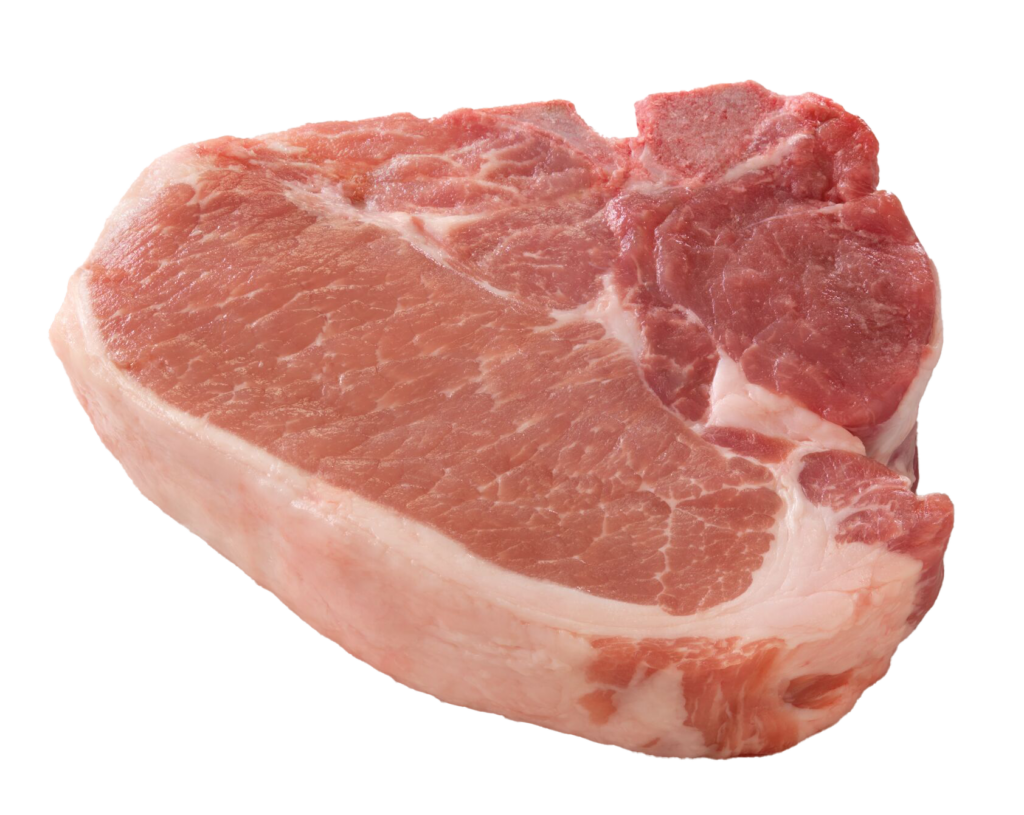
- Cooking Guide:
- Braise
- Grill
- Roast
Large bone-in chop that includes both loin and tenderloin. Excellent for grilling or oven roasting.
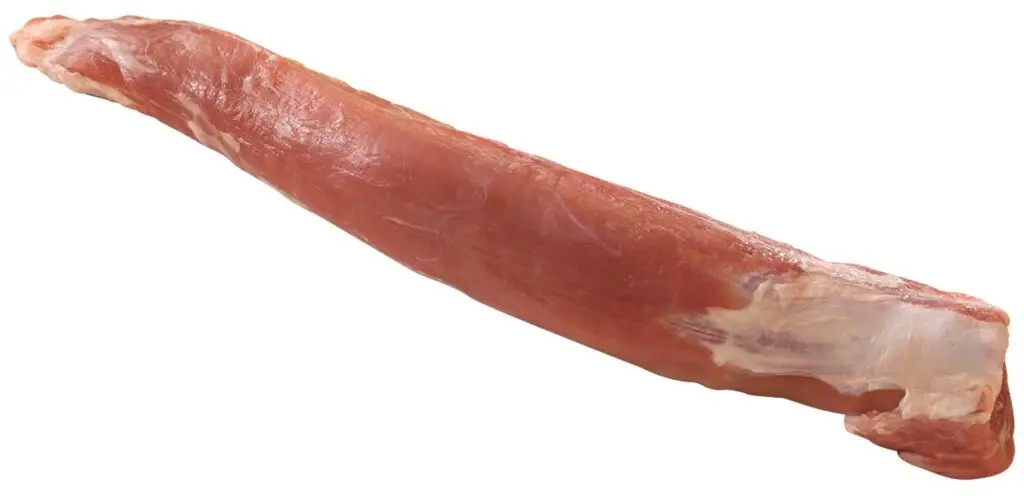
- Cooking Guide:
- Grill
- Roast
- Saute
The leanest and most tender pork cut. Quick-cooking and best when grilled, roasted, or sautéed.
Special Thanks To:
Primal Percentages of Carcass & Additional Data:


Edit Template
LEG
Leg Primal
The Leg, sometimes referred to as the ham, comes from the rear of the pig and is known for its lean, firm meat. It’s typically cured and smoked to make ham, but fresh leg cuts can also be roasted, braised, or cut into steaks for a variety of hearty dishes.

Some Cut Possibilities from the Leg
Please Note: You won’t receive all cuts listed below from a single animal. The final options depend on what you prioritize, and what your processor is able to provide. Depending on the number of cut options available from a single muscle, you can typically choose between two and four options for each primal area.
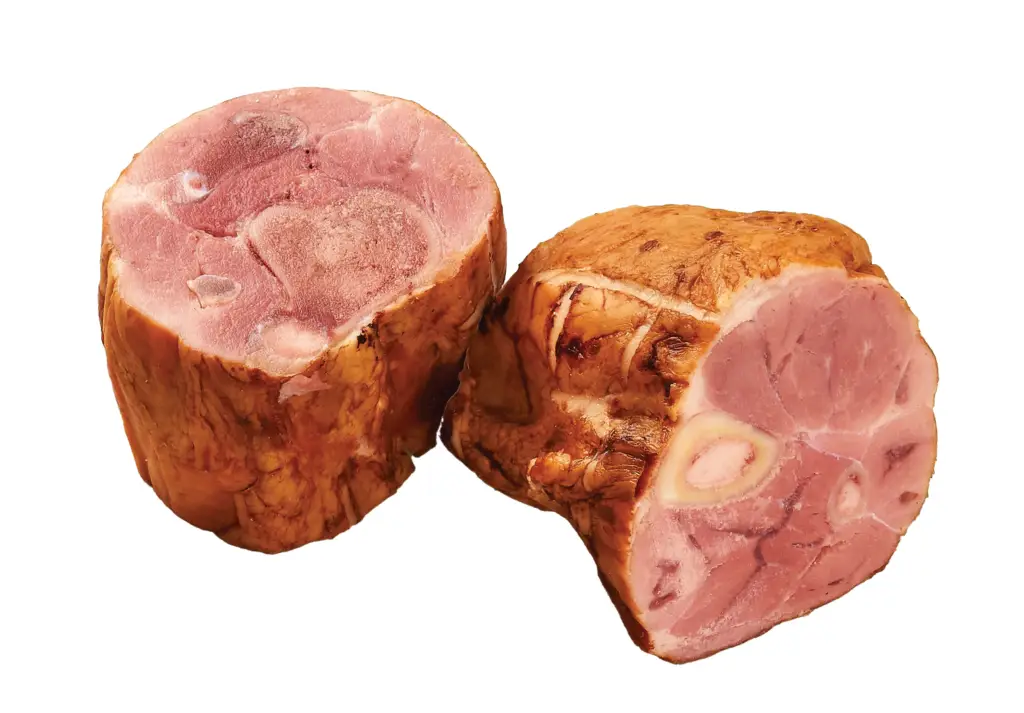
- Cooking Guide:
- Braising
Rich and flavorful, the ham shank is best braised low and slow for tender, fall-off-the-bone meat.
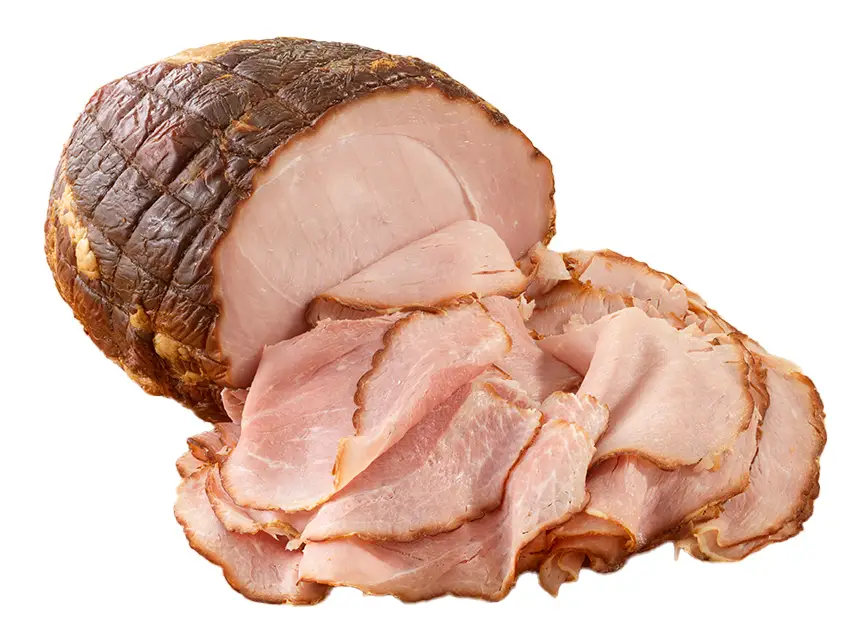
- Cooking Guide:
- Grilling
- Roast
Versatile and savory, whole ham roasts beautifully or grills well—perfect for hearty meals and holiday centerpieces.
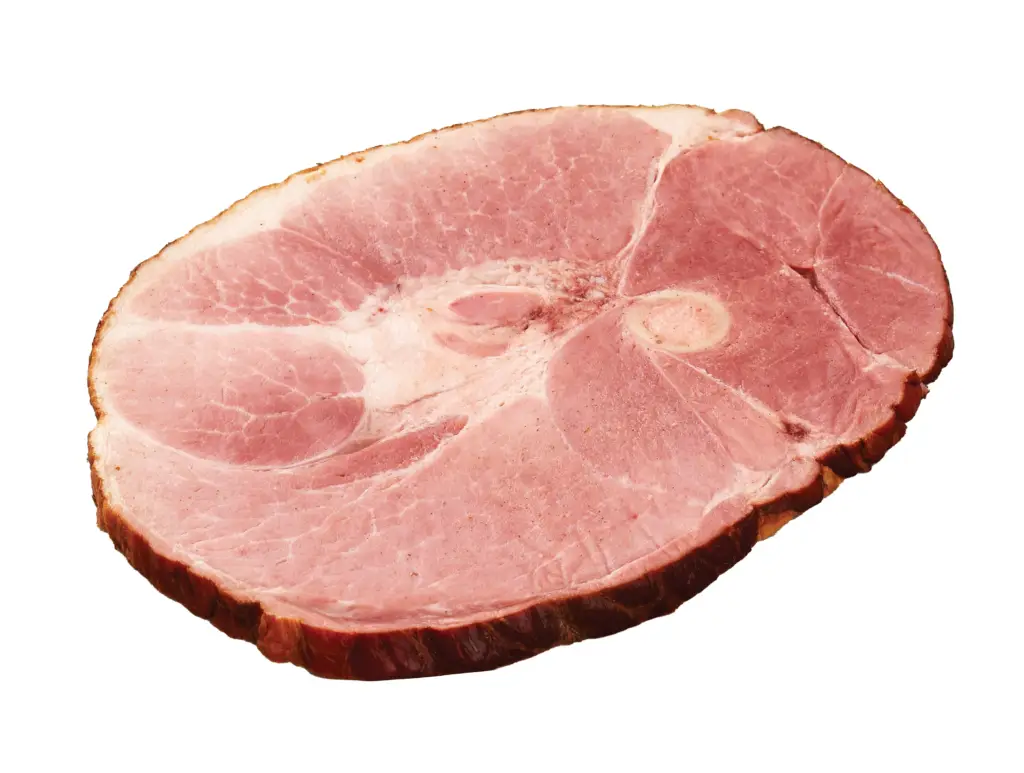
- Cooking Guide:
- Sauteing
- Grilling
Thick-sliced and juicy, ham steak is ideal for quick grilling or sautéing, delivering smoky flavor in minutes.
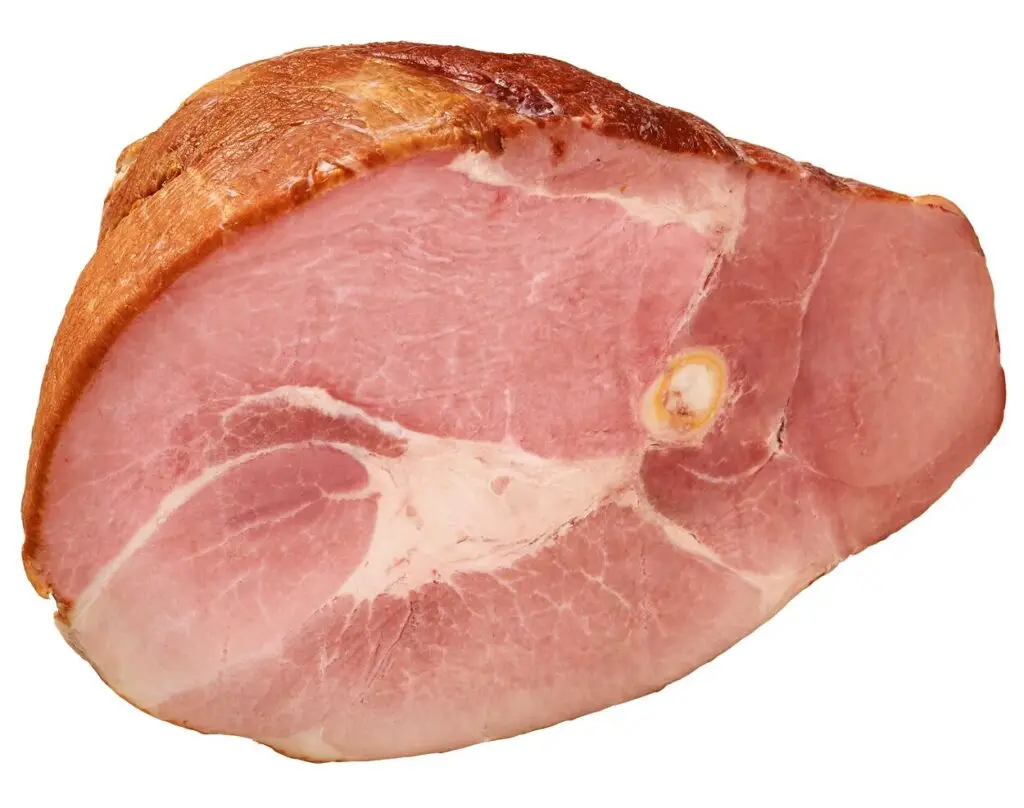
- Cooking Guide:
- Grilling
- Roast
Slow-roasted or grilled, this bone-in ham offers deep, smoky flavor and juicy meat—great for feasts or leftovers.
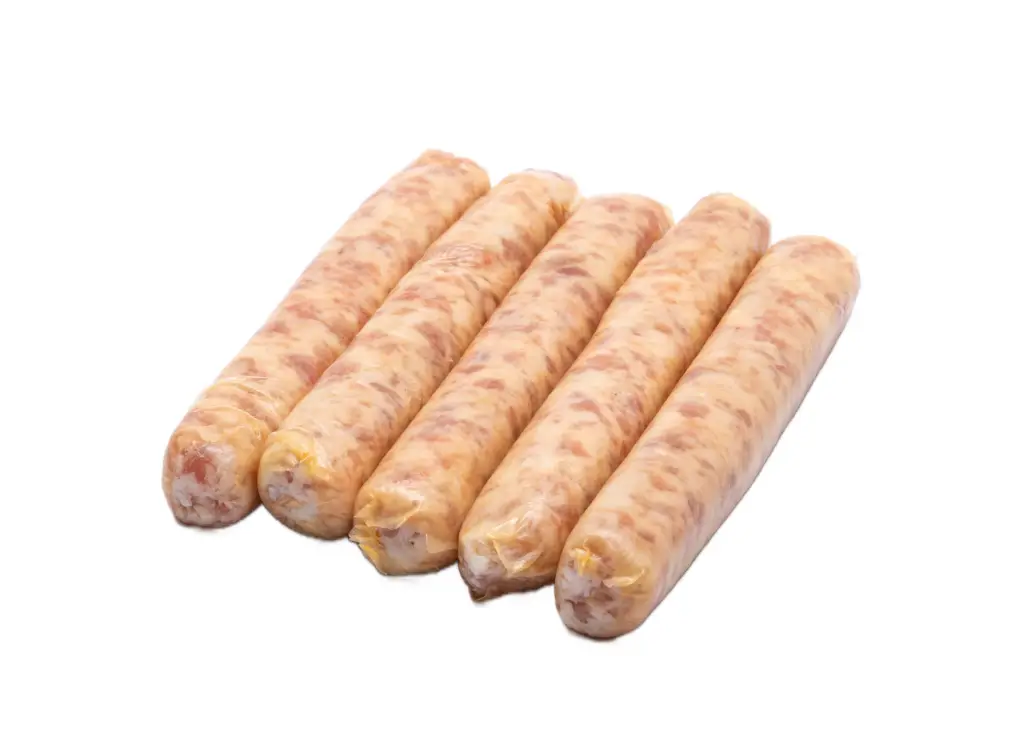
- Cooking Guide:
- Sauteing
- Stewing
- Grill
- Roast
Made from seasoned ground pork. Perfect for breakfast, grilling, or stews depending on the style and seasoning.

- Cooking Guide:
- Sauteing
- Grilling
Mild and adaptable, ground pork works in stir-fries, sauces, meatballs, and patties. Takes on flavor easily.
Special Thanks To:
Primal Percentages of Carcass & Additional Data:


Edit Template
SIDE
Side Primal
The Side, also known as the belly, comes from the underside of the pig and is valued for its layers of meat and fat. It’s commonly used to produce bacon, but also works well for slow roasting or braising to bring out its rich, savory flavor.

Some Cut Possibilities from the Side
Please Note: You won’t receive all cuts listed below from a single animal. The final options depend on what you prioritize, and what your processor is able to provide. Depending on the number of cut options available from a single muscle, you can typically choose between two and four options for each primal area.

- Cooking Guide:
- Sauteing
- Roast
Savory and crisp, cured bacon is best sautéed or roasted, adding smoky richness to breakfasts, salads, or main dishes.
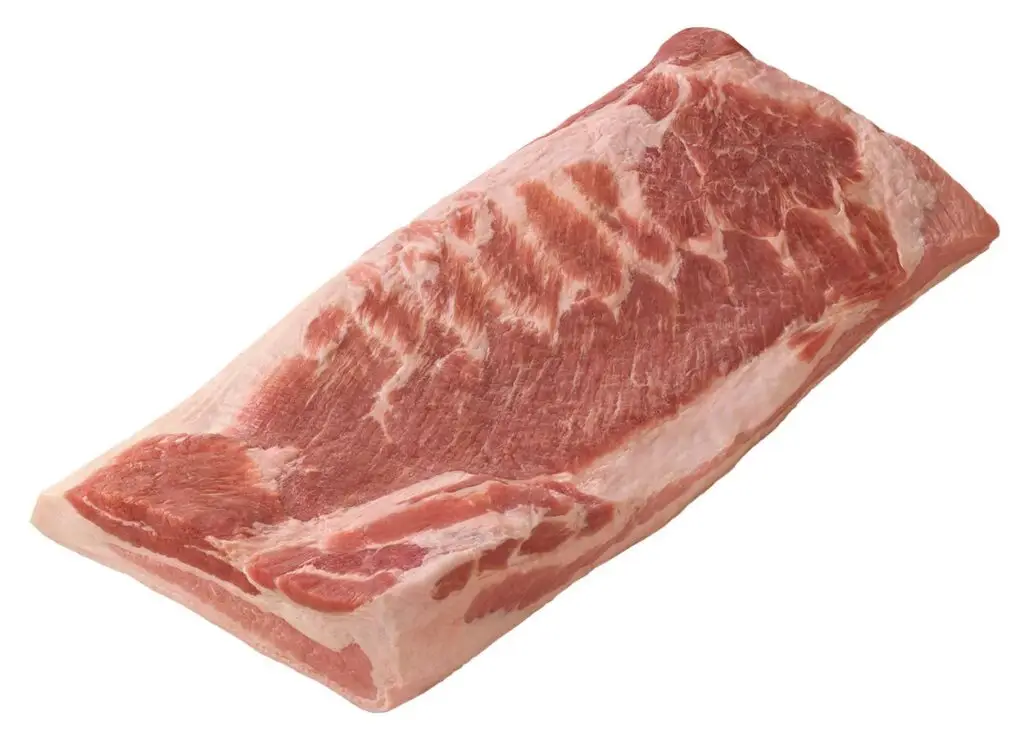
- Cooking Guide:
- Braising
- Roast
Fatty cut perfect for roasting or braising—ideal for shredding, with deep flavor when cooked slow or smoked. Usually made into cured bacon.

- Cooking Guide:
- BBQ
- Roast
Rich and meaty, spareribs are ideal for BBQ or roasting, offering bold flavor and tenderness with slow cooking.

- Cooking Guide:
- BBQ
- Roast
These ribs shine with slow roasting or BBQ, turning incredibly tender and flavorful when cooked low.
Special Thanks To:
Primal Percentages of Carcass & Additional Data:


Edit Template
SHOULDER
Shoulder Primal
The Shoulder, often called the picnic shoulder, is located just below the butt on the front leg. It has more connective tissue and slightly less marbling, making it perfect for slow roasting, braising, or smoking to create moist, flavorful dishes.

Some Cut Possibilities from the Shoulder
Please Note: You won’t receive all cuts listed below from a single animal. The final options depend on what you prioritize, and what your processor is able to provide. Depending on the number of cut options available from a single muscle, you can typically choose between two and four options for each primal area.
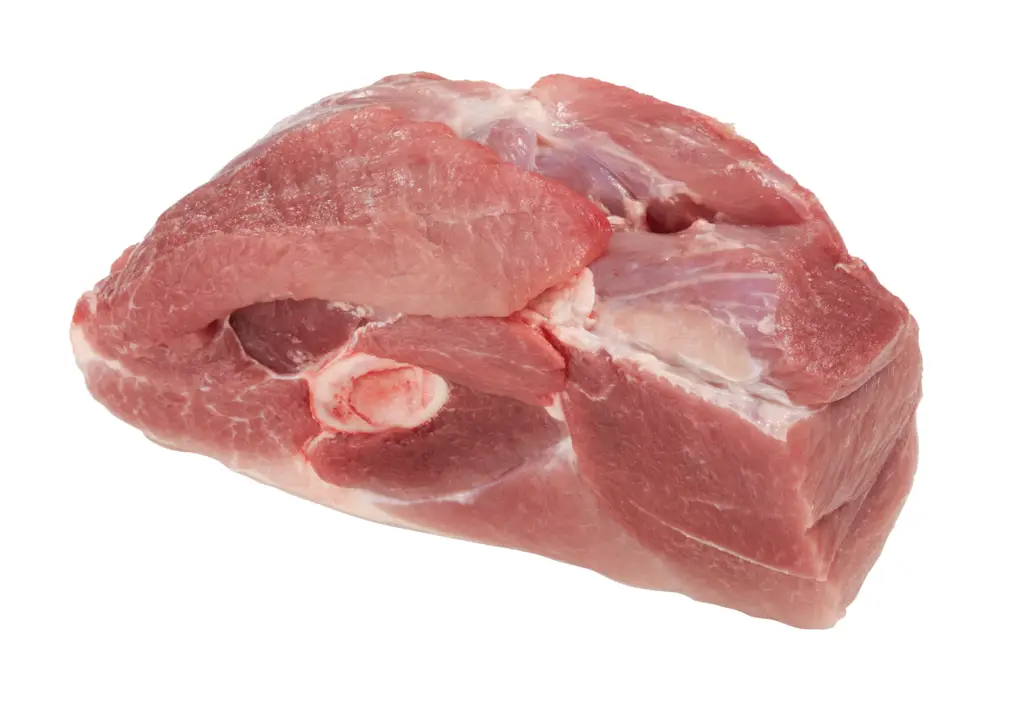
- Cooking Guide:
- Braising
- Stewing
- BBQ
- Roast
Lean and tender, this boneless roast is ideal for braising, stewing, roasting, or quick, dry-heat grilling methods.
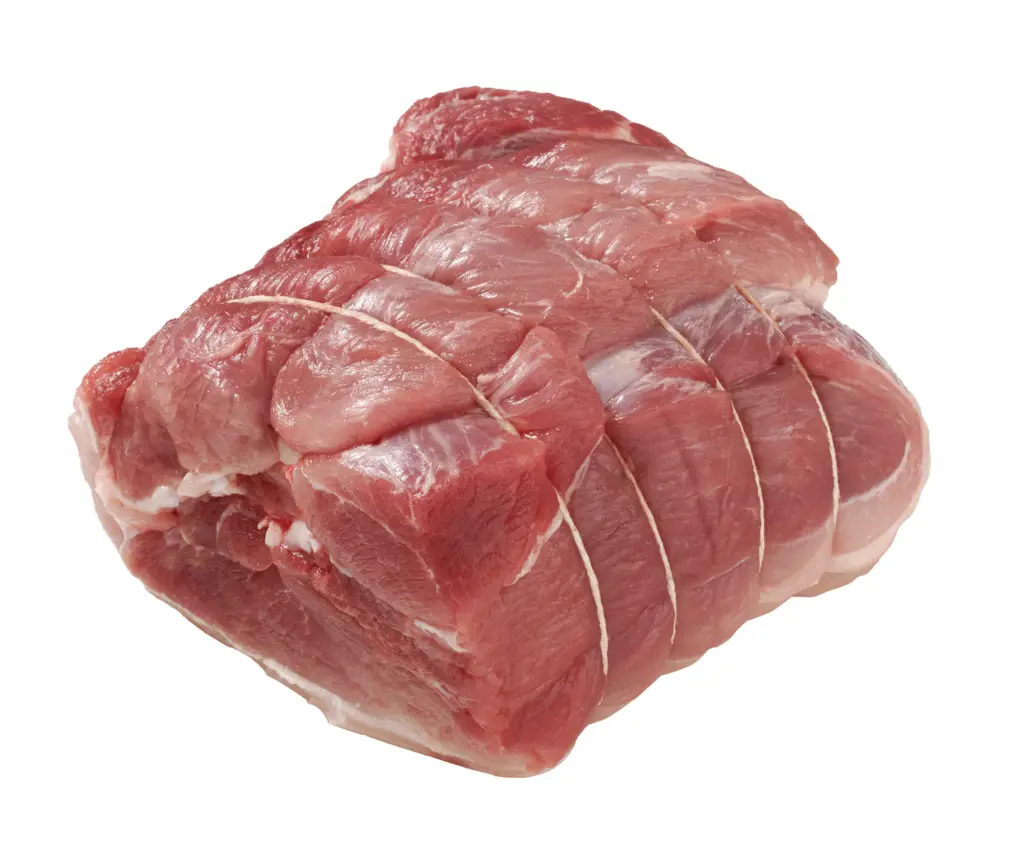
- Cooking Guide:
- Braising
- Stewing
- BBQ
- Roast
A flavorful cut with tenderloin and strip, great for braising, BBQ, or finishing in the oven after pan-searing.

- Cooking Guide:
- Sauteing
- Stewing
- Grill
- Roast
Made from seasoned ground pork. Perfect for breakfast, grilling, or stews depending on the style and seasoning.

- Cooking Guide:
- Sauteing
- Grilling
Mild and adaptable, ground pork works in stir-fries, sauces, meatballs, and patties. Takes on flavor easily.
Special Thanks To:
Primal Percentages of Carcass & Additional Data:


Edit Template